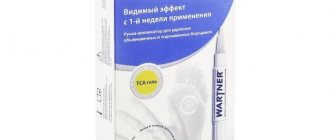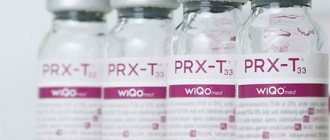What is plasma therapy
Let's consider this issue in more detail.
Let's start with the fact that, when talking about cosmetic procedures, it is not entirely correct to use this term, although the name “plasmotherapy” has stuck. What is plasma therapy really? This is the treatment of various diseases with blood plasma by administering it intravenously. Plasma therapy is used in general medicine.
Plasmolifting originated from another medical procedure - PRP therapy. PRP stands for platelet-rich plasma, and the therapy itself is the use of platelet gel in surgery to heal soft tissue.
Do you know what? The method has many names - plasma biorevitalization, plasma revitalization, autoplasma skin therapy. But the most striking thing is Dracula therapy!
Plasmolifting is a modification of this method, and is based on the regenerating property of platelets.
Although plasma has only recently been used in cosmetology - the method was patented by Russian doctors in 2004 - the excellent results from its use quickly made the procedure popular.
What is blood plasma
Our blood consists of formed elements - cells, and biological fluid in which the cells “float” - plasma. 92% of plasma consists of water, which contains the following components:
- proteins;
- lipids (fats);
- amino acids;
- enzymes;
- glucose;
- vitamins;
- microelements.
As you can see, the composition of human plasma is very rich, so it itself can be used in the form of a high-quality meso-cocktail.
However, the main rejuvenating effect comes from the enrichment of this liquid with platelets.
How platelets work
Platelets are flat, colorless blood cells whose task in case of injury is to stop blood loss, ensure rapid healing of soft tissues, disinfect the lesion site and deliver nutrition to the surface of the vascular wall.
If the integrity of the tissue is violated, platelets immediately rush to the wound, destroying the pathogenic bacteria that have entered it and forming a clot that clogs the hole. Later, they begin to secrete special proteins - growth factors, which stimulate cell division and growth at the site of injury. This is how the wound heals.
If you deliver an increased number of platelets to a certain area, the brain will perceive this as a signal - “there was an injury, we urgently renew the tissue!” This starts the process of active production of “building material” for skin cells - collagen, elastin, hyaluronic acid.
Thus, by performing platelet-rich plasma injections , you will not only saturate your skin with vitamins, amino acids and minerals, but also start your own recovery processes.
Indications for plasma therapy
Since the effect of introducing platelet plasma is based on the regenerating, anti-inflammatory, disinfecting effect of platelets, as well as the nourishing effect of plasma, the range of application of this technique is quite wide.
Indications for plasma lifting are:
- Signs of skin aging - decreased elasticity, the presence of facial wrinkles, initial ptosis of the oval of the face.
- “Extra” skin on the face and neck after sudden weight loss.
- Grayish, pale complexion, unless caused by internal diseases.
- The presence of shallow scars.
- Rehabilitation after laser resurfacing and peeling.
- Recovery from ultraviolet burns after exposure to the sun or solarium.
- Acne.
- Severe dry skin.
- Correction of the consequences of unsuccessful administration of botulinum toxin.
Plasma injections into the face and neck are among the safest cosmetic procedures, but not everyone can perform them.
Contraindications
Contraindications to the use of hemorejuvenation are:
- Take any blood thinning medications less than two days before the injection.
- Pregnancy and breastfeeding.
- Any disease in the acute phase.
- Injections of hormonal drugs less than two weeks before the procedure.
- Treatment with antibiotics.
- Severe forms of diabetes.
- Any blood diseases.
- Anemia.
- Reduced level of platelets in the blood.
- Immunodeficiencies.
- Oncological diseases.
- Allergic reactions to anticoagulants and heparin.
- Mental disorders.
In the first 2-3 days of the monthly cycle, it is better to refrain from performing the procedure.
Benefits of plasma therapy
The technique of autologous cellular rejuvenation is quite young, but its advantages are obvious.
Collagen, elastin, hyaluronic acid and other building elements of skin cells are produced by the body itself, and are not introduced from the outside.
Since the patient is injected with his own plasma, the likelihood of allergic reactions and side effects is minimized.
Rejuvenation is not visual, “facade” in nature, but actually occurs from the inside, due to the activation of local immunity and regenerative processes. The effect of the procedure lasts up to 2 years, after which it can be repeated. It has a wide range of effects and is used as a rehabilitation and treatment program.
Although plasma injections cannot be called a comfortable manipulation - after all, these are multiple injections - it is much less painful than conventional mesotherapy. The relative painlessness of the procedure is achieved due to the neutral acid-base balance of the blood and its biocompatibility.
Plasma transfusion
Oncology clinic in Moscow ¦ BLOOD TRANSFUSION FOR CANCER PATIENTS ¦ Plasma transfusion
Transfusion of blood and its components
Transfusion of blood and its components is most often carried out in very severe diseases, when it is necessary to compensate for the lost volume of blood or the deficiency of any of its fractions, including formed elements and proteins.
Until now, under the blood is an effective remedy that cannot be replaced by anything, since there are no medicinal analogues that can duplicate its functions, at least partially.
For this reason, every large hospital has a supply of donor blood and its individual components, which are used according to appropriate indications.
Blood transfusion at the European Clinic
In the European Clinic of Surgery and Oncology, transfusions of blood and its individual components occur quite often, since there are patients with severe somatic and oncological pathologies and their condition requires replacement of the volume of blood and its formed elements.
Very often there are situations when there are no other alternatives and a transfusion can not only save a life, but also quickly improve the patient’s well-being.
The combination of traditional and advanced methods of influencing pathology allows doctors at the European Clinic to achieve excellent results in treating patients and improving their general condition.
Blood plasma
Plasma is obtained from whole blood by centrifugation or plasmapheresis, which removes the formed elements of blood: red blood cells, white blood cells, platelets.
The difference between plasma and serum is that plasma contains the anticoagulant sodium citrate, which prevents the formation of fibrin clot and the loss of certain proteins.
Naturally, plasma, unlike serum, contains fibrin, antihemophilic globulin and other factors.
Blood plasma is often used for diagnostic purposes, for example, in bacteriological studies to test microbial coagulase, or in determining the clotting ability of blood to initiate thrombus formation.
From the same volume of blood, different volumes of plasma and serum are obtained: the plasma content is approximately 10% higher than the serum due to the fact that the process of fibrin formation binds part of the fluid.
How is blood plasma used?
Blood plasma is used for transfusions for various pathological conditions. It contains a large amount of nutrients, coagulation factors, elements of the anticoagulant system, enzymes, hormones, immunoglobulins, antibodies and other components.
Doctors prefer to use frozen plasma rather than lyophilized or native plasma.
During storage and lyophilization, the breakdown of proteins is much more intense than during freezing, which makes the plasma not so effective, because some of the active components no longer work.
Frozen plasma is stored for a year at -45ºС, after which it is disposed of as biological waste.
If there is a need for plasma transfusion, it is carefully thawed and warmed to +38ºС.
In this case, fibrin flakes may fall out. If they are not very large, then they are not paid attention to, since there are filters in the plasma transfusion system. If large flakes or films are formed, then such plasma is disposed of.
An important role in the choice of plasma for transfusion is played by the antigenic compatibility of the donor material with the recipient's body.
Antibodies can destroy red blood cells, and, in addition, plasma proteins are quite immunogenic and can provoke anaphylactic shock, which, as a rule, manifests itself in the first minutes of plasma transfusion.
Indications for plasma transfusion
Disseminated intravascular coagulation is an indication for plasma transfusion. With this disease, generalized activation of the coagulation system occurs as a result of the release of a large amount of thromboplastin into the bloodstream.
As a result of this process, the proteins of the coagulation system are depleted and numerous hemorrhages and a tendency to bleed are observed; in severe cases, hypotension and a state of shock develop.
Plasma transfusion allows one to replenish coagulation factors, as well as normalize the content of anti-coagulation proteins.
In general, normal plasma restores the disturbed hemostatic balance. In case of chronic disseminated vascular coagulation, plasma is supplemented with substances that prevent coagulation.
Blood plasma is often used for acute blood loss, and its volume makes up about a third of all infusion solutions.
The value of plasma is to maintain normal oncotic pressure inside the vessels and counteract hydrostatic pressure. In addition, the blood plasma contains iron transport proteins (transferrin, ferritin), which help restore hemoglobin levels.
With serious liver diseases and the development of liver failure, the content of coagulation factors and other proteins synthesized in this organ drops sharply, which provokes bleeding, hemorrhages, and hematomas.
To avoid major complications, the lack of these factors is compensated for by blood plasma components.
For blood clotting disorders of various etiologies, plasma transfusions can be used. Sometimes the cause is coagulopathy, dicoumarin overdose, or thrombocytopenic purpura. In all these cases, plasma proteins help restore physiological hemostasis.
Complications and contraindications for plasma transfusion
Despite the fact that all donor material is tested for major infectious agents, sometimes a complication of plasma transfusion can be bacterial or viral infection.
For example, if the recipient’s body did not have the Epstein-Barr virus, then transfusion of components with this virus can provoke infectious mononucleosis.
In cases of heart failure (for example, after a myocardial infarction), plasma transfusion can lead to an increase in circulating blood volume and increased workload on the heart. For this reason, these patients are given plasma slowly under cardiac monitoring.
If the plasma contains high titers of anti-erythrocyte antibodies, its administration can provoke hemolysis of red blood cells and kidney problems. The development of anaphylactic shock is possible, since plasma proteins can be immunogenic for the recipient's body.
Immediately after the transfusion, a skin rash, as a reaction to increased histamine levels, and a fever are likely to occur. The latter can be provoked, among other things, by hemolysis of red blood cells and then the transfusion is stopped.
A severe complication of plasma transfusion is respiratory distress syndrome, in which blood pressure and hemoglobin drop: this indicates damage to the lung tissue and requires resuscitation measures and artificial ventilation.
Despite the dangers that blood and plasma transfusions pose, the potential benefits for human health and life in certain conditions are very great and can literally snatch the patient from the clutches of death.
Strict adherence to indications and identification of contraindications, compliance with instructions and professional standards allows you to minimize the risks associated with this procedure.
+7(925)191-50-55 – European treatment protocols in Moscow
REQUEST TO THE CLINIC
Source: https://www.rusmedserv.com/oncoclinic/BLOODTRANSFUSION/Transfusionplasma/
Preparation for plasma injections
Although the use of plasma in cosmetology is one of the most environmentally friendly methods, it is necessary to prepare for a course of procedures. You need to visit a therapist 2-3 weeks in advance and make sure there are no contraindications.
You will need to take the following tests:
- General and biochemical blood tests.
- Blood test for infections - hepatitis, HIV, RW.
Before carrying out plasma lifting, it is advisable to carry out detoxification and drainage procedures.
5-7 days before the start of the course you need to give up alcohol and caffeine. It is better to perform the procedure on an empty stomach. If it is scheduled for the second half of the day, a light breakfast is allowed, excluding fatty, spicy, smoked and fried foods.
Basic parameters and properties of plasma
Quantitatively, P. is characterized by the concentrations of electrons $n_e$ and ions $n_i$, their cf. temperatures (energies) $T_e$ and $T_i$, degree of ionization (fraction of ionized atoms) $α=n_i/(n_i+n_0)$, where $n_0$ is the concentration of neutral atoms, cf. charge of the ion $Z_{eff}$. The high mobility of plasma particles (especially electrons) ensures screening of the charge introduced into the plasma at distances on the order of the Debye screening radius $r_D$ for times on the order of the inverse plasma electron (Langmuir) frequency, $ω_{re}=\sqrt{4πn_ee^2/m_e },$ where $e$ and $m_e$ are the charge and mass of the electron; here and below, the formulas use the Gaussian system of units (GSS); Temperature in P. physics is usually measured in energy. units (1 keV≈107 K). The spatial and temporal scales are usually small, so the concentrations of positive and negative charges turn out to be almost the same $(|Z_{eff}n_i-n_e|/n_e≪1)$; in this sense, they speak of the quasi-neutrality of P. This most important property of P. is often used to determine P., following I. Langmuir, who first used it in the 1920s. the term "P." to designate the quasineutral region of the gas discharge remote from the electrodes. Typically, the lifetime and size of a particle exceed $r_D$, respectively, which ensures its quasi-neutrality. P.'s quasineutrality does not contradict the presence of volumetric electricity. fields in a P. located in a magnetic field.
How does the procedure work?
Venous blood in the amount of 40-50 ml is taken from the patient and placed in a test tube with an anticoagulant and separation gel.
The blood is then separated in a centrifuge. It is divided into the following fractions:
- top: platelet-poor plasma (PRP);
- middle: platelet-rich plasma (PRP);
- below - red blood cells and leukocytes.
Reference. Anticoagulants are drugs that prevent blood clotting and the formation of blood clots.
The skin in the affected areas is treated with an antiseptic and topical anesthetic (pain-relieving cream), and then injections of platelet-rich plasma are performed.
After the manipulation is completed, the disinfectant is reapplied. Then healing agents with the addition of PRP are applied.
The amount of blood that is taken from the patient to perform hemorejuvenation is insignificant; the body simply “does not notice” this loss. A woman loses approximately the same amount in one day of menstruation. Therefore, some patients' concerns about increased blood loss are completely unfounded.
You can evaluate how effective the procedure was 2 weeks after it was performed. The full course ranges from 3 to 7 sessions.
Recommendations after plasma therapy
After performing plasma injections, it is necessary to protect the skin from exposure to ultraviolet radiation, water and mechanical stress.
During the week you cannot:
- sunbathe in the sun and in a solarium;
- visit the swimming pool, bathhouse, sauna;
- Do massage;
- perform cosmetic procedures.
Plasma injections into the face and neck may leave minor bruises that go away on their own fairly quickly.
During the plasma lifting course and for two weeks after, it is necessary to use sunscreen when going outside. This is especially true in summer, regardless of sunny or cloudy weather.
Results of plasma therapy
The use of platelet plasma allows you to get a natural face lift without surgery. The skin becomes elastic, moisturized, and pink. The intensity of acne is reduced, shallow scars are smoothed, and the skin texture is evened out.
Patients who underwent this procedure noted that as a result, they visually “threw off” at least 5 years.
The procedure has a prolonged effect - the process of rejuvenation and increased collagen production continues even after the course of procedures. If cosmetic treatment with blood plasma is performed annually, you can significantly slow down the aging process and prolong youth for many years without resorting to plastic surgery and other highly invasive techniques.
At what age and how often can plasma therapy be done?
The most common question from patients is: at what age can the procedure be used? Cosmetologists recommend blood plasma therapy based on indications . If there are serious problems on the skin in the form of pimples and acne, then the age may be quite early - 15 years. As for facial rejuvenation, it is advisable to resort to this method of rejuvenation after 30 years, when the aging process begins to intensify.
The question of how often plasma therapy should be done can be answered this way: for maximum effect, treatment is carried out 2 times a year.
How many sessions are needed to complete the course?
Injections are carried out with a short time interval, the full course of plasma lifting consists of 4-8 procedures depending on the condition of the skin.











